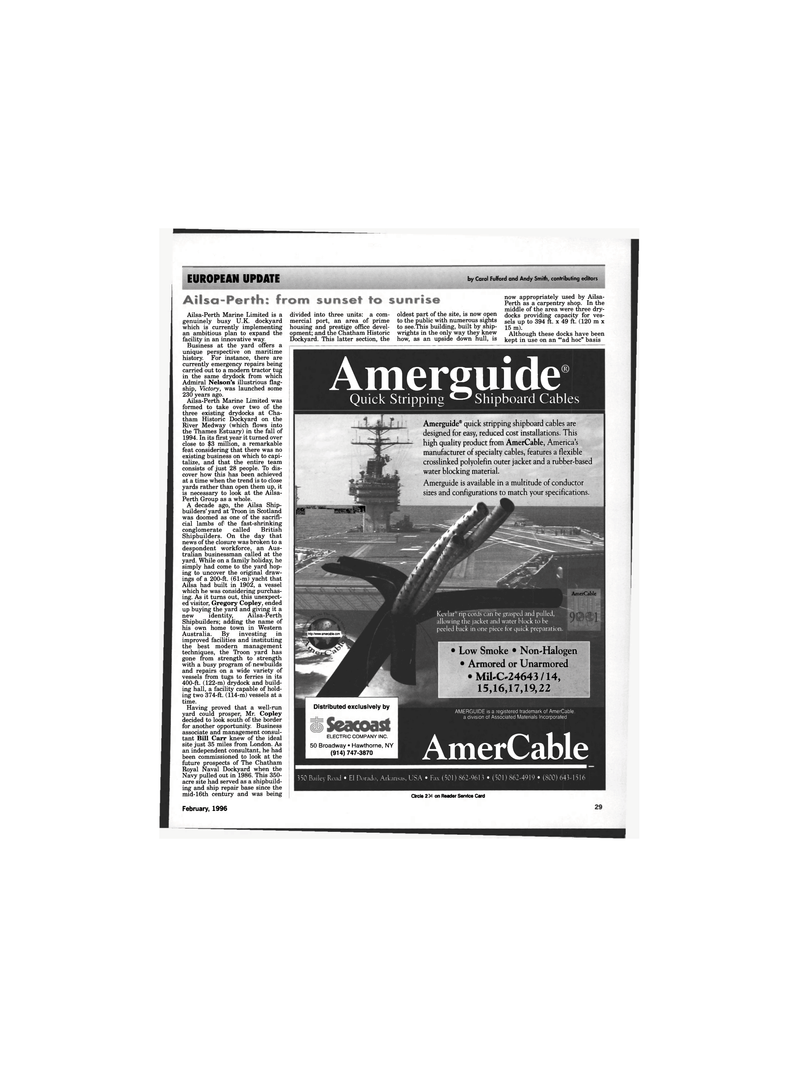
Page 3rd Cover: of Maritime Reporter Magazine (February 1996)
Read this page in Pdf, Flash or Html5 edition of February 1996 Maritime Reporter Magazine
EUROPEAN UPDATE by Carol Fulford and Andy Smith, contributing editors http://www.amercable.com
Amerguide
Quick Stripping Shipboard Cables 350 Bailey Road • El Dorado, Arkansas, USA • Fax (501) 862-9613 • (501) 862-4919 • (800) 643-1516 [ * ' '' ' " • ^
Amerguide® quick stripping shipboard cables are designed for easy, reduced cost installations. This high quality product from AmerCable, America's manufacturer of specialty cables, features a flexible crosslinked polyolefin outer jacket and a rubber-based water blocking material.
Amerguide is available in a multitude of conductor sizes and configurations to match your specifications.
Distributed exclusively by
ELECTRIC COMPANY INC. 50 Broadway • Hawthorne, NY (914) 747-3870
AmerCable
Kcvlar' rip cords can be grasped and pulled, allowing the jacket and water block to be peeled back in one piece for quick preparation. • Low Smoke • Non*Halogen • Armored or Unarmored • MIL-C-24643 /14, 15,16,17,19,22
AMERGUIDE is a registered trademark of AmerCable, a division of Associated Materials Incorporated
AmerCable
Ailsa-Perth Marine Limited is a genuinely busy U.K. dockyard which is currently implementing an ambitious plan to expand the facility in an innovative way.
Business at the yard offers a unique perspective on maritime history. For instance, there are currently emergency repairs being carried out to a modern tractor tug in the same drydock from which
Admiral Nelson's illustrious flag- ship, Victory, was launched some 230 years ago.
Ailsa-Perth Marine Limited was formed to take over two of the three existing drydocks at Cha- tham Historic Dockyard on the
River Medway (which flows into the Thames Estuary) in the fall of 1994. In its first year it turned over close to $3 million, a remarkable feat considering that there was no existing business on which to capi- talize, and that the entire team consists of just 28 people. To dis- cover how this has been achieved at a time when the trend is to close yards rather than open them up, it is necessary to look at the Ailsa-
Perth Group as a whole.
A decade ago, the Ailsa Ship- builders' yard at Troon in Scotland was doomed as one of the sacrifi- cial lambs of the fast-shrinking conglomerate called British
Shipbuilders. On the day that news of the closure was broken to a despondent workforce, an Aus- tralian businessman called at the yard. While on a family holiday, he simply had come to the yard hop- ing to uncover the original draw- ings of a 200-ft. (61-m) yacht that
Ailsa had built in 1902, a vessel which he was considering purchas- ing. As it turns out, this unexpect- ed visitor, Gregory Copley, ended up buying the yard and giving it a new identity, Ailsa-Perth
Shipbuilders; adding the name of his own home town in Western
Australia. By investing in improved facilities and instituting the best modern management techniques, the Troon yard has gone from strength to strength with a busy program of newbuilds and repairs on a wide variety of vessels from tugs to ferries in its 400-ft. (122-m) drydock and build- ing hall, a facility capable of hold- ing two 374-ft. (114-m) vessels at a time.
Having proved that a well-run yard could prosper, Mr. Copley decided to look south of the border for another opportunity. Business associate and management consul- tant Bill Carr knew of the ideal site just 35 miles from London. As an independent consultant, he had been commissioned to look at the future prospects of The Chatham
Royal Naval Dockyard when the
Navy pulled out in 1986. This 350- acre site had served as a shipbuild- ing and ship repair base since the mid-16th century and was being divided into three units: a com- mercial port, an area of prime housing and prestige office devel- opment; and the Chatham Historic
Dockyard. This latter section, the oldest part of the site, is now open to the public with numerous sights to see.This building, built by ship- wrights in the only way they knew how, as an upside down hull, is now appropriately used by Ailsa-
Perth as a carpentry shop. In the middle of the area were three dry- docks providing capacity for ves- sels up to 394 ft. x 49 ft. (120 m x 15 m).
Although these docks have been kept in use on an '"ad hoc" basis
Circle 269 on Reader Service Card
February, 1996 34A

 26
26

 4th Cover
4th Cover
